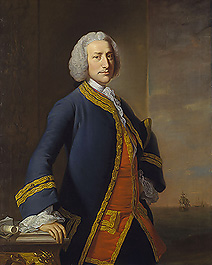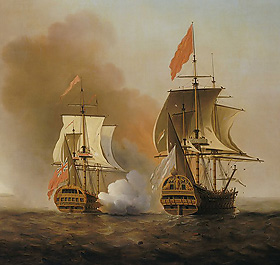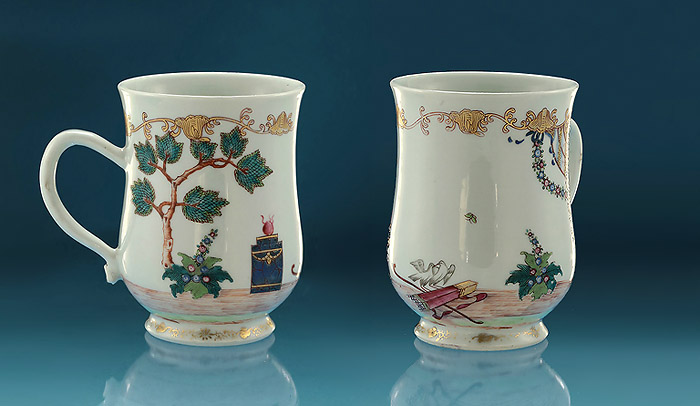 
Portrait of Lord Anson, Thomas Hudson, before1748,
& his
1743 capture of the Nuestra Seņora de Covadonga, with a prize worth £400,00
and ensuring their voyage home; Samuel Scott.
George
Anson entered the navy in February 1712, and by rapid steps became
lieutenant in 1716, commander in 1722, and post-captain in 1724. In
this rank, he served twice on the North American station as captain
of Scarborough and of Squirrel from 1724 to 1730 and
from 1733 to 1735. In 1737 he gained the command of the 60-gun ship
of the line, Centurion. In
1740, on the eve of the War of the Austrian Succession (1740–1748),
he became commander (with the rank of commodore) of the squadron
sent to attack Spanish possessions in South America in the War of Jenkins' Ear.
The
expedition failed to carry out its original ambitious scheme.
Anson's ill-equipped squadron sailed later than intended, with only
six warships: HMS Centurion (flagship), Gloucester, Severn, Pearl, Wager, and the sloop Tryal,
plus the two store ships Anna and Industry.
Successive disasters eventually reduced his force to just Centurion. Two of his vessels, Pearl and Severn,
failed to round the Horn and returned home. HMS Wager was
wrecked off the coast of Chile, where the crew subsequently
mutinied. The lateness of the season forced him to round Cape Horn
in very stormy weather, and the navigating instruments of the time
did not allow for exact observations. By the time Anson reached the
island of Juan Fernandez in June 1741, only three of his six ships
remained, while the strength of his crews had fallen from 961 to
335. In the absence of any effective Spanish force on the coast, he
was able to harass the enemy and to sack the small port city of
Paita in Peru (13 – 15 November 1741). The steady decrease of his crew by
scurvy, and the worn-out state of his remaining consorts, compelled
him to collect all the remaining survivors in Centurion. He rested
at the island of Tinian, and then
made his way to Macau in November 1742.
Tinian
was an island lush in lush tropical paradise with an abundance of
fruit and other edible greens near the beach but also fresh water
and cattle which had been brought there to provide meat for the
Spanish garrison on Guam. Within just a few days, the men showed
clear signs of improvement. Of
particular note was the breadfruit tree. The fruit is
high in starch and when boiled and then baked has a taste between
potato and bread. The high praise
given it by Dampier's earlier expedition and the crew of the
Centurion later prompted Joseph Banks to send HMS Bounty, under
Captain Cook, to take the plant to the Caribbean to feed plantation
slaves.
.
Continuing the westward
journey, in 1743 he harbored at Canton, where
he and his men were instrumental in saving Canton from a fire which
would otherwise have destroyed the entire city. In recognition, a porcelain service – known as “Valentine
Pattern” - was commissioned for Anson, depicting items drawn
from the sketches of his resident artist on that voyage.
After
considerable difficulties with the Chinese, he sailed again with his
one remaining vessel to cruise in search of one of the richly laden
Manila galleons that conducted the trade between Mexico and the
Philippines. The indomitable
perseverance he had shown during one of the most arduous voyages in
the history of sea adventure gained the reward of the capture of an
immensely rich prize, Nuestra Señora de Covadonga, possessing
1,313,843 pieces of eight, which he encountered off Cape
Espiritu Santo on 20 June 1743. Anson took his prize back to Macau,
sold her cargo to the Chinese, and sailed for England, which he
reached via the Cape of Good Hope on 15 June 1744. The prize money
earned by the capture of the galleon had made him a rich man for
life, and it enabled his heirs to rebuild Shugborough Hall, the
family estate.
Anson's chaplain, Richard Walter,
recorded the circumnavigation, which he included in A Voyage Round
the World published in 1748. It is, "written in brief,
perspicuous terms", wrote Thomas Carlyle in his History of
Friedrich II, "a real poem in its kind, or romance all fact; one
of the pleasantest little books in the world's library at this
time".
|


